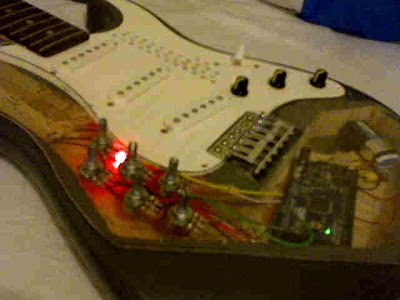- Powered by a USB cable, not a 9V battery (battery was a bit flat)
- Jack socket is connected by crocodile leads (need to drill a hole)
- Only two strings (couldn't be bothered to string up the whole thing)
- Most sensors still missing but it should be pretty easy to add them
- Currently have six knobs and an infra-red sensor
- Missing various push buttons, rocker switches, light sensor and accelerometer
- Missing the "virtual strings" and fret sensors, which will require many extra weeks of thought
Matt's Pointless Technology
Music, as explored from an inventor's perspective.
Monday, 16 April 2012
Guitar Update Number Three
Wednesday, 4 April 2012
The Home Straight?
- Power distributed to sensors via blocks of screw terminals with LED power indicators
- Three working MIDI output ports
- LCD screen with four-button menu system (up, down, enter, back)
- Ability to add as many sensors as there is room for on the guitar without horrendous wiring issues
- Wire in six knobs, two push buttons and a light sensor
- Add 9V power socket and latching on/off push switch
- Attach guitar pickups to smaller output jack and restring guitar
- Fret detection and strum detection (as seen in a previous video), with note data sent to a synthesiser
- Miniature keyboard
- Accelerometer
Saturday, 25 February 2012
Something Softer
Yesterday, I published my first music app to the Android Market. The app is pretty unhelpful, inefficient and ergonomically unsatisfying, but the point is that it works, it's been published, and it was completed in roughly a day. I wanted to go through the process of designing, writing and publishing an Android app to see what was difficult and what wasn't. Here are some things I learned:
1) Although audio latency in Android is woeful, the stability of the audio stream seems pretty decent.
2) Flash makes it very easy to write and package apps, but it's very easy to slow an app to a standstill if you're not careful.
3) The search functionality in Android Market is geared towards showing people the top twenty apps for a particular search term, which is not great for small developers.
4) I've just realised that this blog has become nerdy and technical. Sorry. Here is the link to the app:
Friday, 10 February 2012
Guitar Update Number Two
Saturday, 4 February 2012
Very basic MIDI guitar system
Technical info: I am aware that there are far too many wires in this video.
Strummable Resistors
Tuesday, 24 January 2012
Guitar Update Number One Point Five
- I'm now using the actual microcontroller (circuit board) that will be in the guitar, the Arduino Mega 2560. This has a lot more inputs and outputs than the Arduino Uno, which I was using before.
- The menu system is now pretty much fully functional, allowing me to route any sensor to any MIDI parameter and adjust settings such as the minimum and maximum values a sensor can transmit.
- I can now connect three MIDI devices simultaneously (I have been having tremendous fun controlling my synth and sampler at the same time).
- I have tracked down a large sheet of transparent plastic which will be cut down to size and used as a giant scratch-plate to mount the sensors (and cover the large hole in the guitar).
